Apple Ermine Moth: the pest that’s decimating Oxford's apple trees
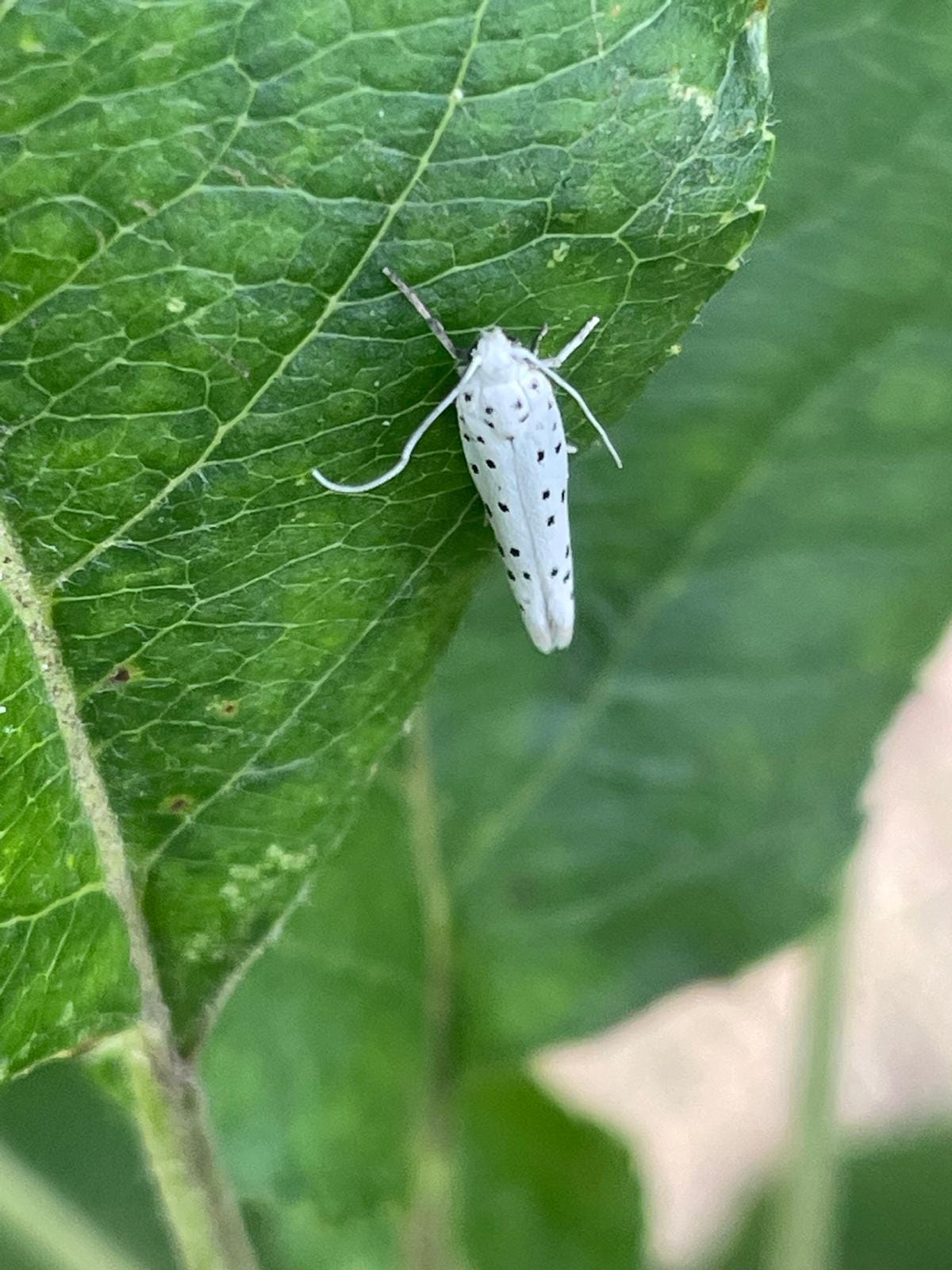
Do you have an apple tree in your garden or on your street? Perhaps you've noticed strange cobweb like sacs ('tents') on the leaves this year. Or perhaps the branches are looking less leafy than usual? Chances are apple ermine moth is the culprit.
Have a look around your trees and see if you can spot them. The eggs hatch and form tents in early spring, then by summer they turn to moths, leaving behind a melon pip sized chrysalis, and a tree covered in dead skeletal leaves, and old tents.
The apple ermine moth, or Yponomeuta malinellus, is cutting a swathe through Oxfordshire's apple trees. It's endemic in East Oxford gardens, and we have heard tell of allotment sites too. It has been seen as far out as Wheatley and it may be in your garden, slowly hurting your your tree, and your future apple harvests. It has decimated this Somerset cider brandy orchard this year. It likes trees that haven't been cared for – so if you have skipped pruning a couple of years, and the moth looks familiar, read on to save your young trees and/or keep avoid losing a whole harvest.
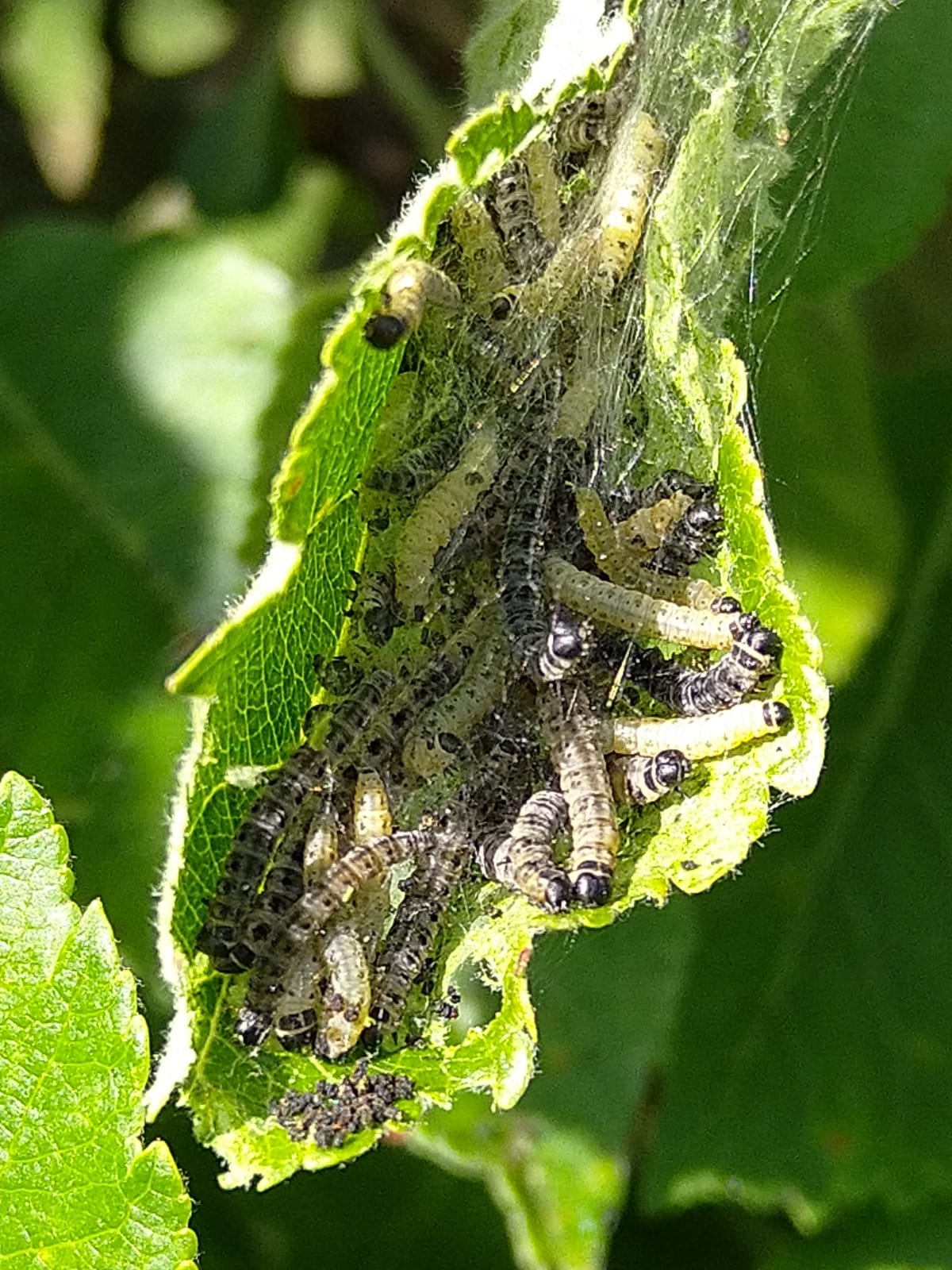
The lifecycle of a moth
The cycle starts with eggs, laid in the summer. Freshly laid eggs are light yellow. They change to bright red within about two weeks, then fade to grey (sadly not a song lyric), which is annoyingly difficult to see on tree bark.
The eggs overwinter as young larvae underneath egg masses – 'hibernaculum' that the females laid on tree bark the previous summer. The larvae sometimes feed on bark under the egg mass, which damages the tree. In early spring, larvae emerge from the protective covering, or hibernaculum, and move to nearby developing leaves. These larvae need to feed. And there are a lot of them. One caterpillar will feed for forty days without interruption. What do they like to eat? Leaves. Your tree needs these leaves to survive, and produce apples. Specifically, photosynthesis stops if there are no leaves, and the root system is effectively suppressed. Consequently the plant completely stops absorbing carbon dioxide and releasing oxygen, and some sources believe this impacts the tree's immunity so it can die outright in winter if it's a young tree, or may struggle even if it's established.
The first sign you might notice is spider-like webs on the twigs and the branches of trees. They usually appear just after the first leaves and blossoms. The tents protect the baby caterpillars from birds while they eat. Once they've eaten the leaves inside the tents, they move elsewhere and spin a new tent. If you see these, you already have an infestation.
Once they have eaten their fill, they cocoon inside their tents. Inside these tents are now piles of white cocoons containing caterpillars who, in a tree-related Kafkaesque nightmare, have fed on your leaves (you will probably already have noticed the lack of leaves) and are metamorphosing into new moths.
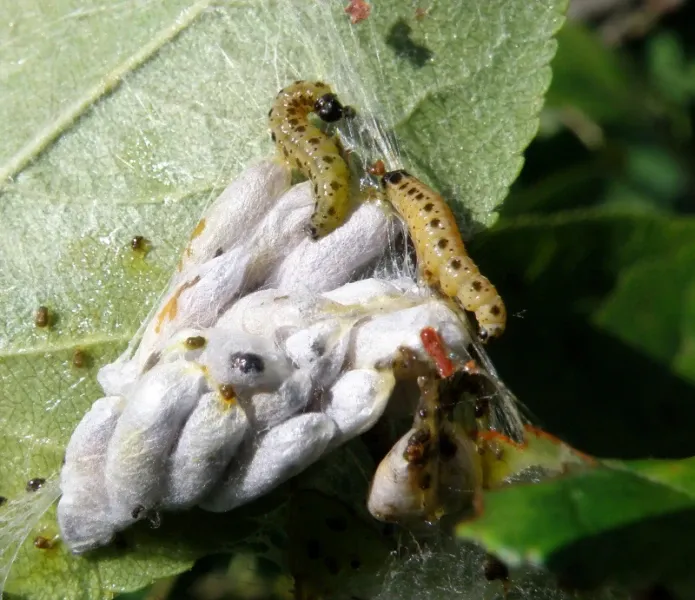
This will leave empty cocoons, and many moths. They emerge as adults and fly in July and August. In 10-12 days after turning into butterflies they mate and lay eggs, up to 70 each, and the whole cycle begins again. So you can see that each year the infestation can get exponentially worse.
The good news is that once the caterpillars have stopped eating, if the tree has survived, it may grow new leaves. Young saplings may not make it. But even an established tree may have missed the blossom stage, which will mean a lesser or missing apple harvest for the year.
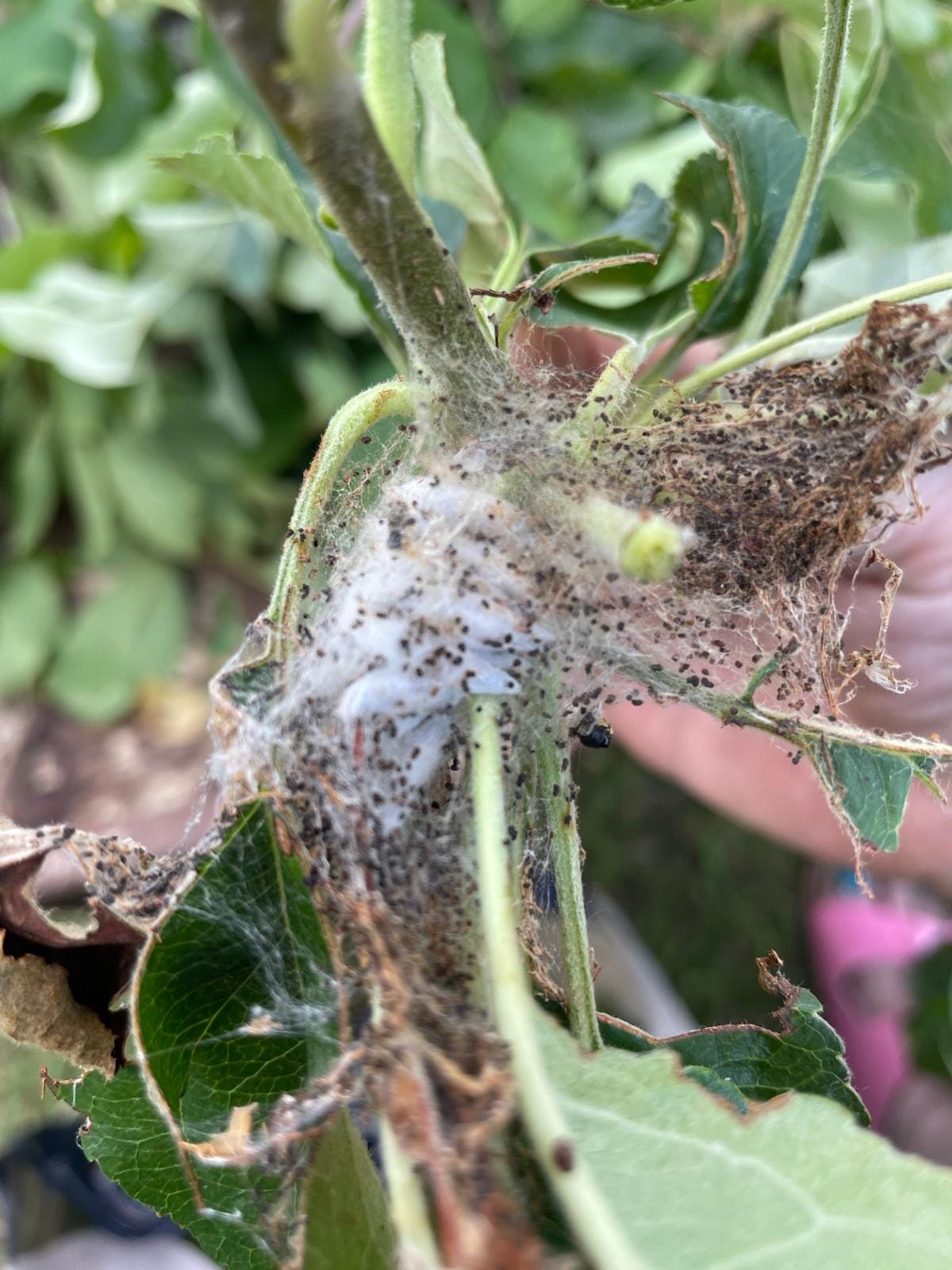
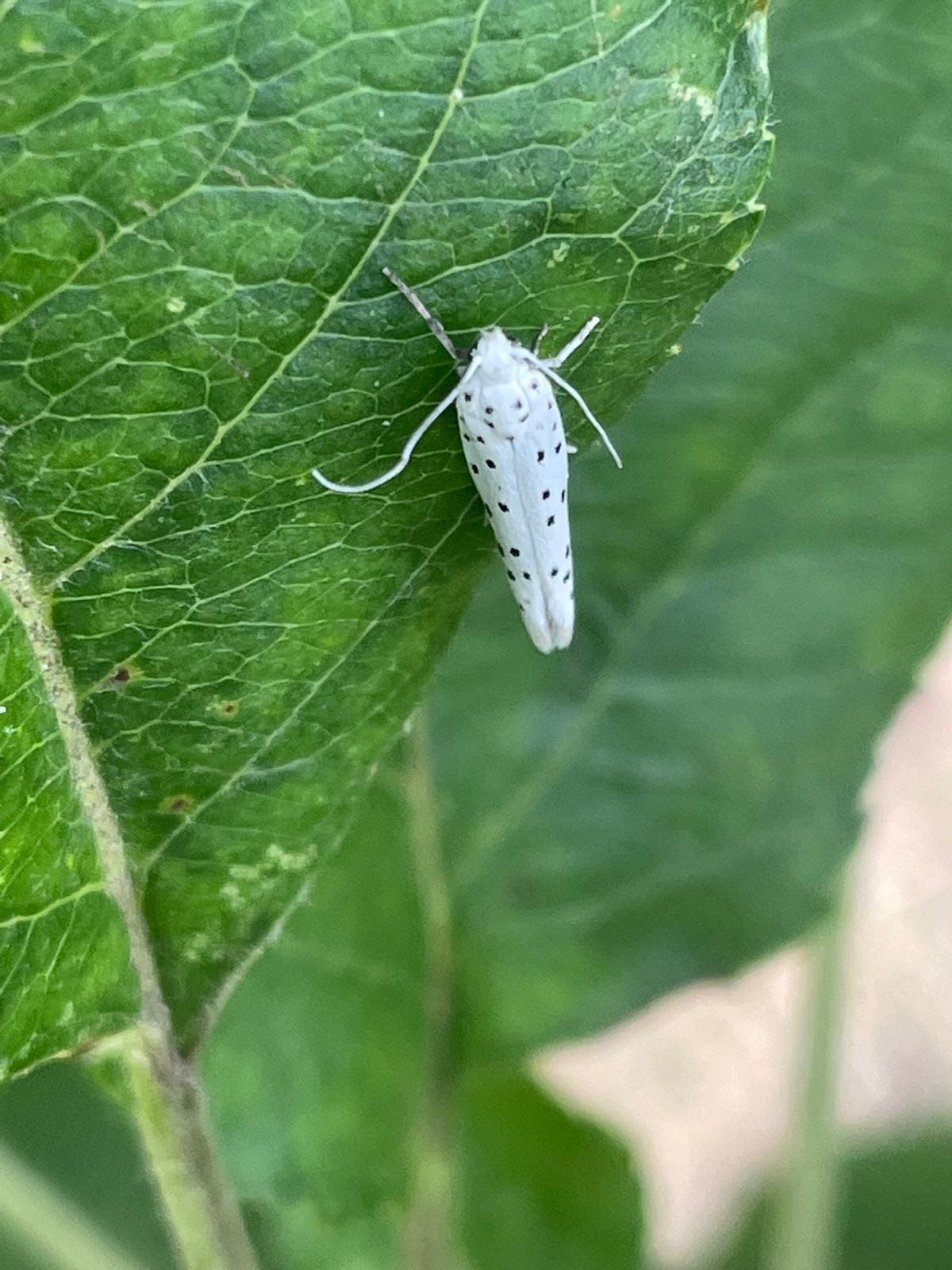
Image 1, an established Apple Ermine moth tent, Image 2, a newly hatched Apple Ermine moth. Source Oxford Clarion. Still not amused.
How to treat an infestation
Opinions differ on this: this is our summary of the most popular methods.
The Royal Horticultural Society advises simply:
Where possible tolerate populations of these caterpillars, as butterflies and moths are an important part of the garden ecosystem and damage to plants is usually only short term
However, the eggs are laid on the trees by the moths, so the infestation becomes progressively worse year after year with exponentially more defoliation. The trees need leaves to survive and produce blossom, and blossom to make apples.
The RHS also advises encouraging predators and other natural enemies in the garden such as birds, hedgehogs and ground beetles, and additionally picking off the webs (of which more later). The organic Somerset orchard referenced in the opening paragraph is investing in ducks to eat the caterpillars. Sadly this may not be a solution for the average Oxfordshire garden, and anyway the Clarion wonders how the ducks get the caterpillars off the trees in the first place.
An alternative option is to interrupt the lifecycle of the moth. Much like clothes moths it is possible, with care, to break the lifecycle without damaging the tree.
Following a strict pruning schedule will help. The eggs are laid on the bark. Removing excess growth will, by definition, remove some of the eggs, which in turn reduces the size of the infestation. Branches that had tents on them will have eggs laid under the bark. Apple trees should be pruned each year in late autumn or winter (November–March); be sure to burn the offcuts. Trees that have not received their winter prune are therefore more likely to be adversely affected by the moths.
The next option is to pick off the tents with their pulsating larvae and destroy them. Not in the compost heap – you must destroy them with fire. The Clarion can attest this is soul-destroying, time-consuming, and requires a strong stomach (and a hat). Swearing and squealing is optional. Optionally, you can high-power hose down the trees to remove the tents and their caterpillars, and stamp on them below the trees to kill them.
Finally, you can interrupt the lifecycle of the adults at mating stage (July/August) by pheromone traps. Much like the commercial traps you can buy for clothes moths, these are sticky traps with a female pheromone lure. The lure attracts male moths, who stick on the traps and die. Without males, the females cannot mate and lay eggs, and the circle is broken. The Clarion has found these traps at Agralan Growers and the Estonian site Baltic Agro, though we have not tried importing from the latter. (Neither are affiliate links.) It is important to buy the correct trap for the correct type of moth: without the right female pheromone you cannot attract the males. To ensure you are trapping the correct type of moth, check your adult moths.
If the infestation is too large to pick the webs off the tree, the RHS gives options for spraying. They advise spraying at dusk, and point out that it needs to be both forceful (to penetrate webbing) and thorough. They cite organic contact insecticides containing natural pyrethrins like Bug Clear Ultra 2, Neudorff Bug Free Bug and Larvae Killer. Non-organic options include lambda-cyhalothrin (found in Westland Resolva Bug Killer), deltamethrin (found in Provanto Ultimate Fruit & Vegetable Bug Killer) and cypermethrin (found in Py Bug Killer). Plants in flower should not be sprayed due to the danger of harming bees and other pollinating insects.
Folk remedies straddle the organic and the pesticide options. We have not tried any of these. Have you? Let us know.
- Chilli or tobacco solution: Grind fresh hot chilli peppers or cigarette butts, add to a litre of water and boil for an hour (use protective gear if chillis!). Let this sit in a closed container for a day. Strain the solution (definitely use protective gear, including eye protection). This is your 'insecticide'. Keep it in sealed containers in the fridge, well labelled.
Dilute half a liter of pepper concentrate and add half a litre of laundry detergent solution. Spray the tree (use protective gear and long sleeves) - Fly ash: Soak 100 grams of fly ash (coal ash – this may be hard to come by in smoke-free Oxford…) in a bucket of water for about a week, stirring occasionally, and then spray the trees.
Save our apples
Sometimes we write articles we know will get clicks. Sometimes we write article that need to be written, even if there are few clicks. Occasionally these two meet in a gloriously Oxfordshire Venn diagram of engagement. This article is from a new contributor (you know who you are, thank you!) and is mainly written in frustration at the lack of homebrew cider from a garden tree this year. So if you've tried any of these remedies, let us know.
If this is the first time you've heard of apple ermine moth, but you've noticed these webs on your trees, buy a pheromone trap now. Set a reminder on your calendar for a vicious prune this November. Just like much of the politics which forms most of the Clarion's output, a community problem requires a community solution. Or there's no apple crumble, no juice and no cider. And that would be a great shame. Cheers!

Further reading
- Royal Horticultural Society: Ermine Moths, Pruning apple trees
- Washington State University: Apple ermine moths
- Thumbgarden: Apple ermine moth pest control
- English Heritage: Clothes moths
